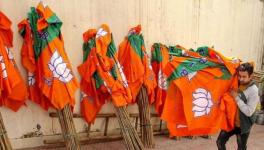Small Scale Sinhora Industry Dying in Bihar
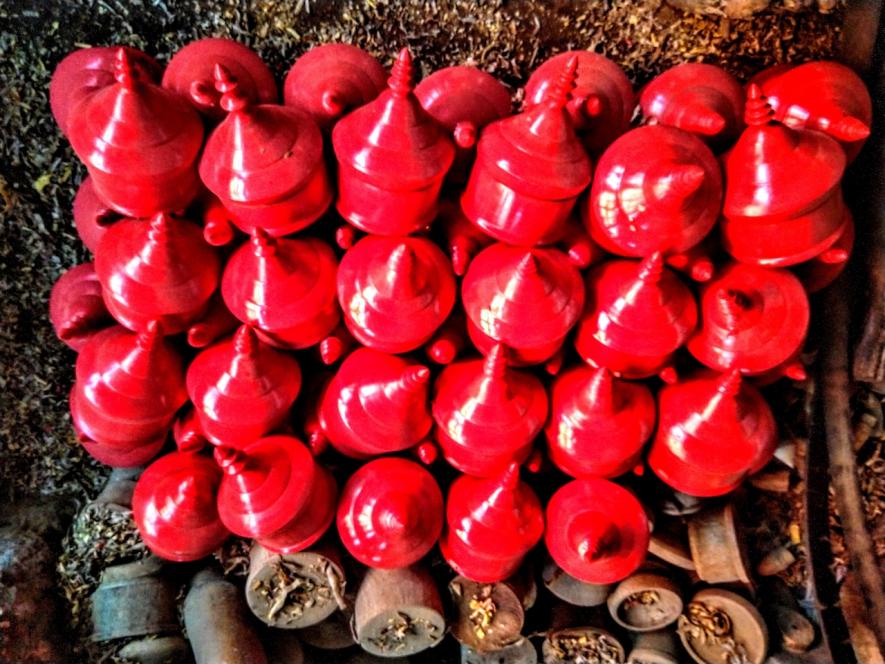
Sinhoras, collocated at the workshop, will soon be transported to the dealer.
“It has been weeks since we tasted onion,” says Jatan Thakur, an elderly woodcarver from West Champaran district in north Bihar, who supports his family of four from his traditional craft and small (2.5 katthas) land-holding. “I am not rich, babua (son),” he says. “Vegetables are a luxury today, how can I buy them with my income?”
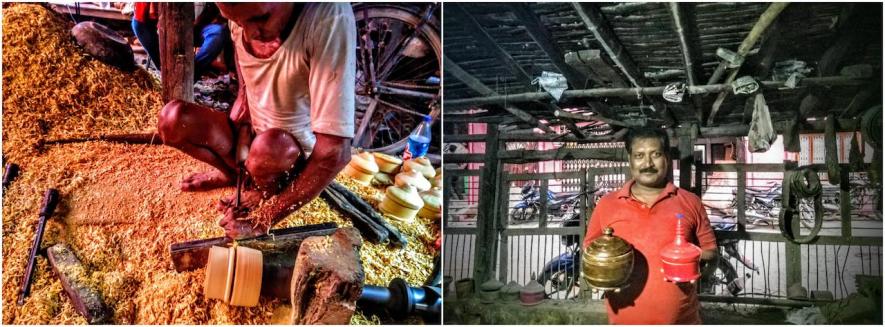
Artisan Jatan [left] is chiselling a medium-sized Sinhora; Bablu Prasad, the workshop owner, is showcasing some replicas of the artefacts earlier produced here.
Sky-high onion prices have kept purchasers such as Prasad away. “People throng the meat shops between Dussehra and Diwali. We can afford chicken once a month. Yesterday a bottle gourd cost me Rs 30,” he says. Rarely does his family meet the nutritional needs of his family. They live below the official poverty line (BPL) and he receives 20 kg rice from the fair-price shop. But that is inadequate and he buys food from the private market too. He has been urging the government to introduce vegetable distribution through the public distribution system or PDS, so that the poorest can afford their basis food requirements.
Every day, Thakur rides his bicycle to the Purani Gudari locality an hour from his village, Parsa-Giri Tola, to find someone willing to buy his woodwork. Like other craftsmen of the area, he works at the workshop of Bablu Prasad—the sole workshop that still remains. They make sinhoras, or the wooden receptacles that Hindu married women in Bihar and eastern Uttar Pradesh store vermilion in.
Thakur does not think of himself as a talented artisan but as a wage labourer. Times are hard. He never went to school, and is unsure how old he is, but filed a few papers at his village panchayat, hoping to receive an old-age pension of Rs400 a month from the government. It is yet to materialise.
Thakur was never interested in the traditional occupation ascribed to members of his caste group, hazam, or barber. But he did not have an inheritance to fall back on either. So, he had brief stints as construction and field labourer. Then he learned how to carve wood figurines, in the style of the local tradition. Since then, Purani Gudari has been his adda or go-to joint.
The government imposed a limit on how much land each family in this region can hold in the early years of India’s Independence. The aim was to redistribute land to tillers, the landless and the poor. But Thakur got no help, for the scheme was never implemented seriously. His village is part of a cluster of settlements called the Barharwa-Yogappati-Giri Tola, dominated by elite-caste maithil brahmins and bhumihars. Members of those communities own most of the local land.
Prakash Jha, a prominent filmmaker, belongs to the same village as Thakur. He had attempted to set up a sugar mill in the area, and is said to have acquired plots of land locally at low rates. But ten years later, the mill has not taken off.
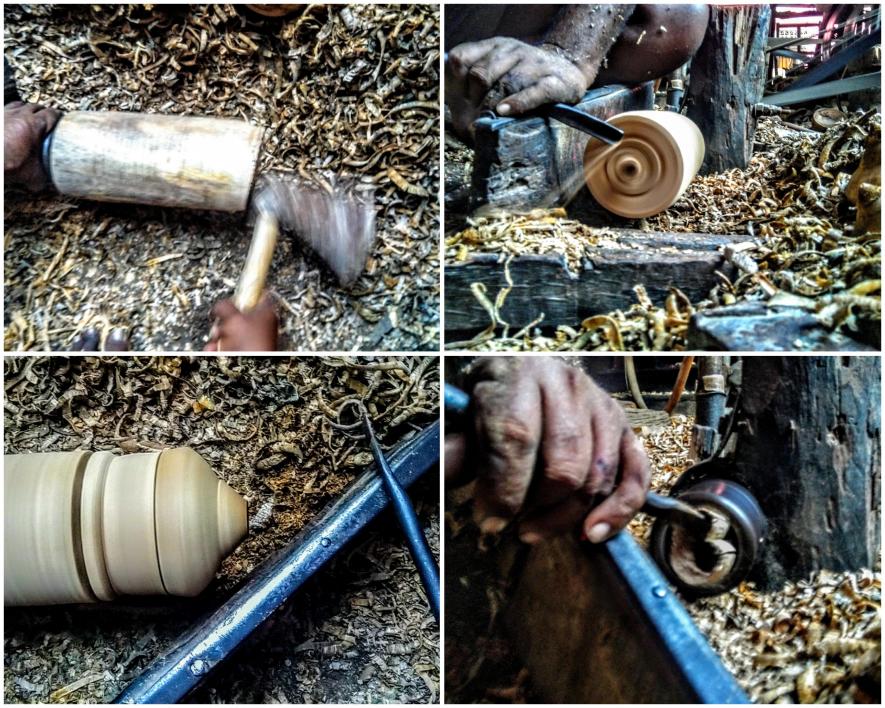
Top Left to Bottom Right: 1. The wooden cylinder is tightly adjusted on shaft. 2. Artisan draws lines and ridges using straight chisel or gouge. 3. After palla or upper part of Sinhora is carved, tarri or peni or container part is grooved with a spoon gouge. 4. The shaft is cleaned for the next cycle.
The local people consider a sinhora something a married woman must cherish. Hindu weddings are incomplete without one. The folklore, however, traces its origin to a dark past. Thakur’s locality once resplendent with the carmine colour of lah, or lacquer. Once there was a Sinhora Square or crossroads in the area, named after the region’s primary trade and craft. This reporter could not find the eponymous landmark—the craft is waning into non-existence, and the area named after it has already vanished.
Just a few years ago there were at least a half-dozen sinhora workshops, now there is only one—Bablu Prasad’s. The others collapsed due to financial hardships, squeezing a once-proud industry out of existence.
Prasad, 45, belongs to the teli caste, traditionally oil-extractors. He found that occupation was not “feasible” and shifted to sinhora-making, in his grandfather’s time. In the 1970s, electro-mechanical workstations were introduced and Bablu developed and expanded his business to accommodate multiple carvers on demand. Now even this trade faces a rapid decline.
“The technology certainly helped us but the market prices of our raw materials, lacquer and mango wood have also gone up,” Prasad says. “Sinhora prices have increased too, but cannot recover the rising costs of making them.”
Mango wood was sold at Rs200 per cubic feet some ten years ago. Now it costs Rs400 per cubic feet. The price of lacquer has fluctuated. Just this year it hit a low of Rs400 per kg to a high of Rs1,000 per kg.
The fate of sinhora-makers is not very different from that of West Africa’s cocoa farmers, judging from the observations of Michael E Odijie, a researcher in the Centre of African Studies at the University of Cambridge. Like the Cocoa farmers, sinhora-makers have no control over prices. They are only “price takers”.
“We make dozens of sinhoras a day for nine months a year but have to sell them to shop-owners at low prices,” says Prasad. The high production costs and low profits from this small-scale business have cornered producers. The electromechanical workstation requires 10 litres of diesel fuel which costs Rs600 daily. There is no regular power supply in the area. The craftsmen in this unit earn between Rs300 and Rs500 a day. “How will Babluji pay more when himself is facing a crisis,” Nur says.
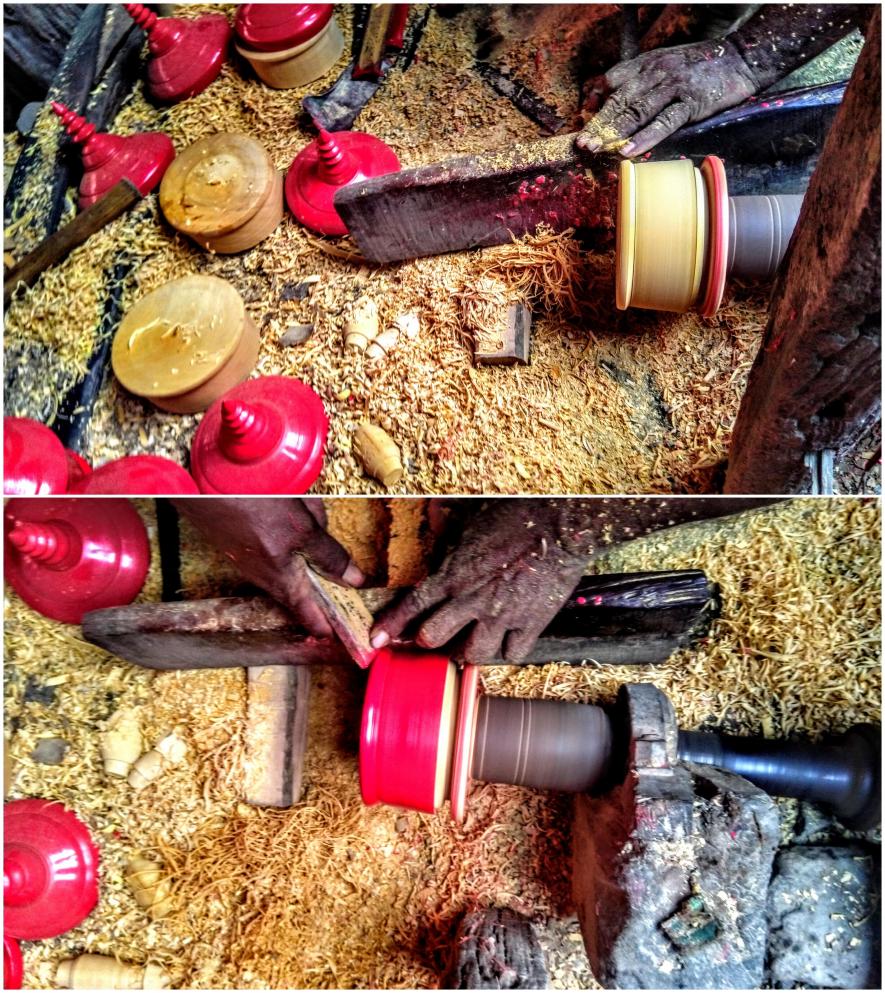
Nur Miyan is doing a quality check. Satisfied by the smoothness of wood scale, he is applying lacquer on Sinhora, thus, giving it a finishing touch.
Prasad attempted to access government schemes meant for small-scale industries, but that never worked out. “I went to the Block Office many times find out the process for officially registering my workshop. The officials always refused to help me. They only say that the process has gone online,” he says. He surfed the website of the district, but the registration portal was inaccessible.
As a result, his enterprise is not “recognised” and cannot avail of loans to grow. Around four years after he started trying to register, he has reached a dead-end.
Primarily due to financial constraints Prasad could not study beyond his matriculation but wants his children, Aarohi and Khushi, in Class 6 and 3 respectively, to study. But his income falls short and he has to borrow from informal sources at a monthly interest rate of 5%. “Thinking about their future education needs scares me,” he says. Prasad’s son Jaswant is in Class 10. His brother partly funds Jaswant’s education, Rs300 a month.
Each sinhora takes some twenty minutes to attain the final colour and shape. Jatan takes some bigger ones, still unfinished, to Nur Muhammad, a quinquagenarian traditional carpenter, to have them brushed with lacquer. Nur works while chewing a betel-leaf preparation. He sloughs off each sinhora on a rotating shaft, holds a chisel (rukhani), a straight gouge or a spoon gouge (bankhi) to them as he carves the wood into shape, gives it ridges and a smooth texture, then polishes them. The electromechanical workstation cannot carve wooden cylinders, so this part of the process is completely manual.
Nur also has a sinhora-making setup at his home in Pakdihaha village of Kumarbagh locality. But he does not have enough capital to run his workshop, so he has taken to wage labourer in this unit. His three sons, Hoda, Ali and Quresh are daily wage carpenters too.
The sons work outside the state, mostly in Kashmir. Nur believes they earn more, being migrant labourers “Or why would they go away from their homeland,” he says.
Prasad and the workers blame their financial crisis on the marginalisation of this artform. They feel that a market “like Dilli Haat” could cater to local demand. If they had such a market, they would even innovate the craft to keep customers interested. He says the government has only promoted the Madhubani style of paintings from the Maithil region of Bihar, in which the West Champaran district falls. “Is not sinhora an art and craft too,” Prasad says.
Six Bihari handicrafts have the Geographical Indicator or GI tag, including Sikki Grass Work of the Tharuhat region of West Champaran. Interestingly, the most famous Sikki Grass product is another kind of container that is gifted to brides to store vermilion. However, the government of India does not recognise sinhora as a handicraft. Moreover, these craftsmen and Prasad have never heard of a GI tag or its significance.
“Some years ago, the wife of a former District Magistrate got some wooden artefacts made here,” Prasad recalls. This is his only memory of help or visits from the district administration. No scheme or program ever helped him.
Sunil Prasad, 32, a close relative of Prasad, had a sinhora workshop not far from here. Now he is just another labourer. “I stopped production because the profits were not good,” he says.
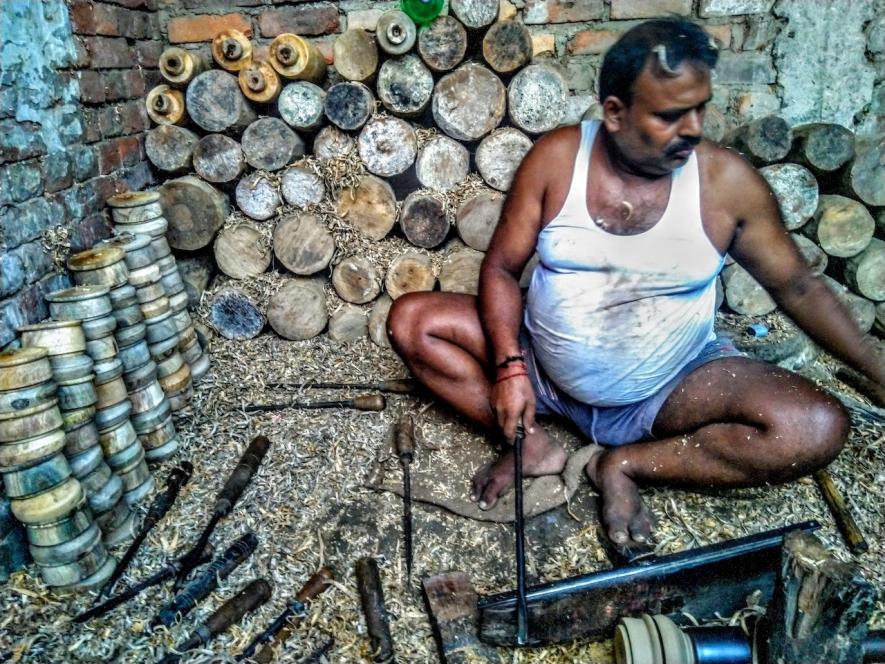
Sunil Prasad
He carves a sinhora in four minutes and when finished it will have a market value of Rs100. The five different sizes of sinhoras made at this workshop sell at Rs100 to Rs300. But the retailers double the rates at which they sell to customers.
Sunil owns a small plot of land, and his workshop had once occupied half his living space. “The scarcity of space also paved the path to closure of my unit,” he says. His old mother, wife and three children live with him. His children are school going-teens, while he can earn only meagre cash labour in exchange for his labour. His skills in woodcraft are Herculean. Like the other artisans, he worries constantly for his children.
Get the latest reports & analysis with people's perspective on Protests, movements & deep analytical videos, discussions of the current affairs in your Telegram app. Subscribe to NewsClick's Telegram channel & get Real-Time updates on stories, as they get published on our website.













